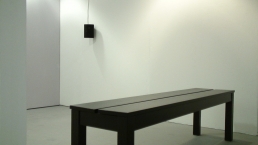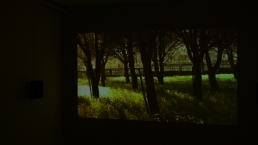Girl with Gun
Girl with Gun developed from my interest in the psychological and archetypal aspects of the phallic female. My intention was to embody this symbol as a means to expose the fraudulent phallus and to reject the insidious politics of castration Vs phallic potency.
The voice-over incorporates quotes from Joan Riviere’s 1929 essay Womanliness as a Masquerade (reprinted in Formations of Fantasy, eds. Victor Burgin, James Donald, and Cora Kaplan, Routledge, New York, 1989) and this frames the interaction between ‘The Girl’ and ‘The Gun’ as a visual metaphor for gender dynamics within a heterosexual relationship.
I was also greatly influenced by Elizabeth Cowie’s book, Representing the Woman: Cinema and Psychoanalysis (Macmillan, Basingstoke, 1997), which explores the power dichotomy of having the phallus and being the phallus, whereby the man requires the unconscious phallic potential of the woman (who perceives herself as castrated) in order to confidently exercise the full extent of his phallic power.
The filmic space is that of the unconscious and therefore the ritual of burial, to quote Hélène Cixous, ‘puts up the immurement of repressions and amnesia into concrete form’. In Three Steps on the Ladder of Writing (trans. Sarah Cornell and Susan Sellers, Columbia University Press, New York, 1993), Cixous wrote (here in relation to Clarice Lispector’s short story ‘The Crime of the Mathematics Professor’):
We/he must bury. We constantly believe we must repress, forget and bury. Yet this isn’t true. The desire to bury hides a much more twisted desire: Man wants to be seen burying – wants to be discovered in the middle of burying (…)
Man only half-buries the dog.
[The Girl only half-buries The Gun].
In fact, he exhibits the burial in such a way it seems like a disinterment.
He must unbury the burying, which is equivalent to bringing what has been repressed back to the surface of consciousness.
The character of ‘The Girl’ refuses to repress the trauma of lack and goes beyond the limits of castration towards a happy death:
Now [she] must sink into the warm sea, lose [herself] in order to find [herself] again, (…) to bring to birth the deep song of [her] happiness.
Quote taken from Albert Camus’ A Happy Death (trans. Richard Howard, Hamish Hamilton Ltd, London, 1971).
The following images document the Slade Degree Show set-up, where I used a full HD projector and 3.1 surround sound. The voice-over was isolated to the one speaker at the back of the room and the ambient sounds where mixed down between the two speakers on the left and right walls of the installation space.


The reason I chose to isolate the voice-over to the back speaker was to create a sense of disembodiment. The voice hovers behind the viewer’s head, suggesting a phantasmatic aural entity which fits in with the metaphysical themes of the film.